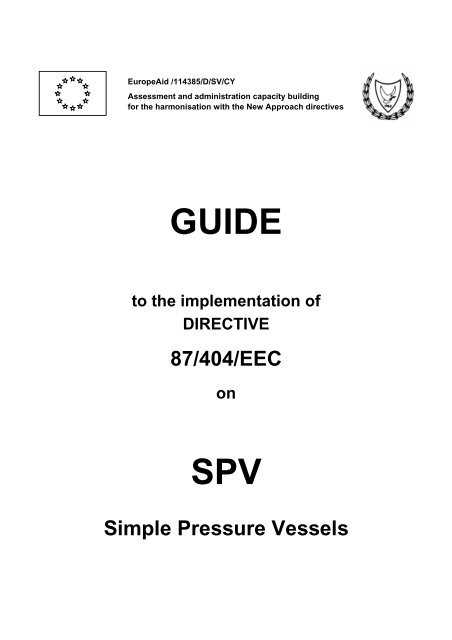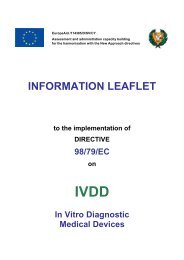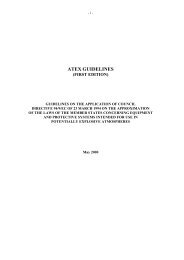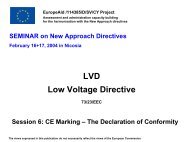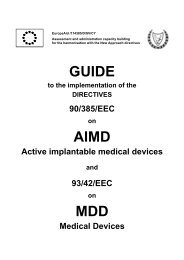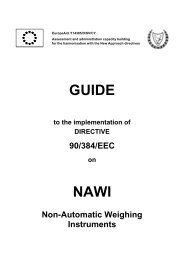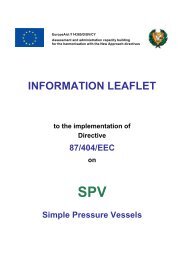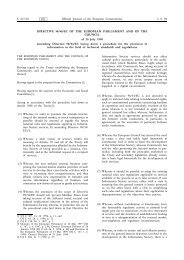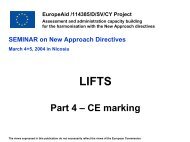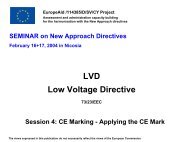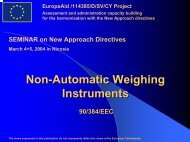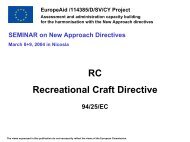GUIDE SPV - Cyprus Organization for the Promotion of Quality
GUIDE SPV - Cyprus Organization for the Promotion of Quality
GUIDE SPV - Cyprus Organization for the Promotion of Quality
- No tags were found...
Create successful ePaper yourself
Turn your PDF publications into a flip-book with our unique Google optimized e-Paper software.
EuropeAid /114385/D/SV/CYAssessment and administration capacity building<strong>for</strong> <strong>the</strong> harmonisation with <strong>the</strong> New Approach directives<strong>GUIDE</strong>to <strong>the</strong> implementation <strong>of</strong>DIRECTIVE87/404/EECon<strong>SPV</strong>Simple Pressure Vessels
Guide on <strong>SPV</strong> DirectiveEuropeAid /114385/D/SV/CYThis Guide was printed with funds <strong>of</strong> <strong>the</strong> EuropeAid /114385/D/SV/CY project:“Assessment and administration capacity building <strong>for</strong> <strong>the</strong> harmonisation with <strong>the</strong> New Approach directives”The views expressed in this publication do not necessarily reflect <strong>the</strong> views <strong>of</strong> <strong>the</strong> European Commission,or <strong>the</strong> Ministry <strong>of</strong> Commerce, Industry and Tourism, or <strong>the</strong> Ministry <strong>of</strong> Labour and Social Insurance.© Republic <strong>of</strong> <strong>Cyprus</strong>, Nicosia, May 2004
Guide on <strong>SPV</strong> DirectiveEuropeAid /114385/D/SV/CYSIMPLE PRESSURE VESSELS - THE DIRECTIVE IN BRIEFDIRECTIVE 87/404/EECCouncil Directive 87/404/EEC <strong>of</strong> 25 June 1987 on <strong>the</strong> harmonization <strong>of</strong> <strong>the</strong> laws <strong>of</strong> <strong>the</strong> Member Statesrelating to simple pressure vessels.Short name:Base:Amendments:Simple Pressure VesselsDirective 87/404/EECDirective 90/488/EEC [Introduction and transitional period (expired)]Directive 93/68/EEC [CE Marking]Equipment and systems containing a fluid or gas under pressure can cause death, or injury, to people if<strong>the</strong> contents are released unintentionally. They can also cause serious damage to property.A large number <strong>of</strong> workplaces and a number <strong>of</strong> work practices have or use a varied range <strong>of</strong> equipment orplant that are pressure systems. Some typical examples are:• Boilers and steam heating systems;• process plant and piping;• air compressor sets (fixed and portable);• pressure cookers, autoclaves & retorts;• heat exchangers & refrigeration plant;• level gauges and pressure gauges;• pumps and compressors;• valves and filters;• pipe work and flexible hoses.LEGISLATION ON PRESSURE SYSTEMSThe Simple Pressure Vessel Directive 87/404/EEC covers pressure vessels manufactured in series, <strong>for</strong>use in air or nitrogen service.The Pressure Equipment Directive (PED) was adopted in May 1997. It covers <strong>the</strong> manufacture and <strong>the</strong>con<strong>for</strong>mity assessment <strong>of</strong> pressure equipment and assemblies with a maximum allowable workingpressure greater than 0,5 bar.The Transportable Pressure Equipment Directive (TPED) 99/36.EC. It covers <strong>the</strong> manufacture and <strong>the</strong>con<strong>for</strong>mity assessment <strong>of</strong> all <strong>the</strong> transportable pressure equipment and is to be applied toge<strong>the</strong>r with <strong>the</strong>Directives 94/55/EC (ADR) and 96/49/EC (RID) (regarding <strong>the</strong> transportation <strong>of</strong> dangerous substances).Above mentioned directives places duty on any person who designs, manufacturers, imports, or suppliesany pressure system, or any article which is intended to be a component part <strong>of</strong> any pressure system. The
Guide on <strong>SPV</strong> DirectiveEuropeAid /114385/D/SV/CYperson must ensure that <strong>the</strong> pressure system or article is properly designed and properly constructed fromsuitable materials so as to prevent danger. The directives also give requirements <strong>for</strong> <strong>the</strong> marking <strong>of</strong> <strong>the</strong>vessels and <strong>the</strong> in<strong>for</strong>mation to be supplied with <strong>the</strong> system. Additionally, it places duties on users (orowners <strong>of</strong> mobile systems) to ensure <strong>the</strong> installation and continued use <strong>of</strong> pressure systems is safe. Thedirectives do not apply <strong>of</strong>fshore, where specific legislation covering design, construction and operation isin <strong>for</strong>ce.EXCEPTIONS TO PRESSURE SYSTEMSThere are certain pressure equipment and systems, though technically covered by <strong>the</strong> definitions in <strong>the</strong>directive that are excepted from <strong>the</strong> requirements, ei<strong>the</strong>r in part or entirely. Reference must be made to<strong>the</strong> directives <strong>for</strong> <strong>the</strong> full list <strong>of</strong> exemptions. Some examples are:• any pressure system which is an electrical or telecommunications cable;• any part <strong>of</strong> a tool or appliance (designed to be held in <strong>the</strong> hand) which is a pressure vessel;• any tyre used or intended to be used on a vehicle.There<strong>for</strong>e from 1 May 2004 :Most simple pressure vessels with a stored energy <strong>of</strong> over 50 bar liters, including imports, when suppliedin a member state must:• meet <strong>the</strong> essential safety requirements;• have safety clearance (which involves checking by an approved body);• bear CE marking and o<strong>the</strong>r specified inscriptions;• be accompanied by manufacturer's instructions;• be safe.Most simple pressure vessels with a stored energy <strong>of</strong> up to 50 bar. liters, including imports, when suppliedin a member state must:• be manufactured in accordance with engineering practice recognized as sound in a country within<strong>the</strong> European Economic Area (EEA);• bear specified inscriptions (but not CE marking);• be safe.Similar requirements apply to such vessels when taken into service in <strong>the</strong> member state by <strong>the</strong>manufacturer or importer.There are o<strong>the</strong>r provisions affecting manufacturers, importers, suppliers and users.The Directive does not apply to exports to countries outside <strong>the</strong> EEA.
Guide on <strong>SPV</strong> DirectiveEuropeAid /114385/D/SV/CYFREE MOVEMENT OF GOODSAchieving <strong>the</strong> free movement <strong>of</strong> goods lies at <strong>the</strong> heart <strong>of</strong> achieving an open market <strong>for</strong> business inEurope.In May 1985, European Community Ministers agreed on a 'New Approach To Technical Harmonisationand Standards' in order to fulfil this objective.'New Approach' Directives (that is Community laws) set out 'essential requirements' (<strong>for</strong> safety, <strong>for</strong>example), written in general terms, which must be met be<strong>for</strong>e products may be placed on <strong>the</strong> market in<strong>the</strong> Community. European standards fill in <strong>the</strong> detail and are <strong>the</strong> main way <strong>for</strong> businesses to meet <strong>the</strong>'essential requirements'. The Directives also say how manufacturers are to show that products meet <strong>the</strong>'essential requirements'.Products meeting <strong>the</strong> requirements are to carry CE marking, which should mean that <strong>the</strong>y can be suppliedanywhere in <strong>the</strong> Community, provided <strong>the</strong>y are safe.The Simple Pressure Vessels Directive 87/404/EEC, as amended by Directives 90/488/EEC and93/68/EEC, is one such Directive.The Directive applies to:• simple pressure vessels ('vessels') are vessels which are intended to contain air or nitrogen at agauge pressure greater than 0,5 bar but less than or equal to 30 bar and not intended to beexposed to flame. They are manufactured in series and are <strong>of</strong> welded steel or aluminiumconstruction;• relevant assemblies that is any assembly incorporating a vessel.Prohibition on supply and taking into service: <strong>the</strong> Directive makes it an <strong>of</strong>fence:• <strong>for</strong> any person being:• <strong>the</strong> manufacturer <strong>of</strong> a vessel;• <strong>the</strong> manufacturer <strong>of</strong> a relevant assembly who imported <strong>the</strong> vessel incorporated <strong>the</strong>rein from acountry or territory outside <strong>the</strong> EEA; or• <strong>the</strong> person who imported a vessel or relevant assembly from such a country or territory.to supply in <strong>the</strong> Member States:• a vessel, unless it complies with <strong>the</strong> safety requirements (see below);or• a relevant assembly, unless <strong>the</strong> vessel incorporated in that assembly complies with <strong>the</strong> safetyrequirements.• <strong>for</strong> <strong>the</strong> manufacturer <strong>of</strong> a vessel himself to take into service in <strong>the</strong> Member State:• that vessel, unless it complies with <strong>the</strong> safety requirements; or• a relevant assembly incorporating that vessel, unless <strong>the</strong> vessel complies with <strong>the</strong> safetyrequirements.• <strong>for</strong> <strong>the</strong> importer into <strong>the</strong> Member State <strong>of</strong> a vessel or a relevant assembly to take into service in <strong>the</strong>Member State:• that vessel, unless it complies with <strong>the</strong> safety requirements;
Guide on <strong>SPV</strong> DirectiveEuropeAid /114385/D/SV/CY• a relevant assembly incorporating that vessel, unless <strong>the</strong> vessel complies with <strong>the</strong> safetyrequirements; or• <strong>the</strong> imported relevant assembly, unless <strong>the</strong> vessel incorporated in that assembly complies with <strong>the</strong>safety requirements.The Directive also makes it an <strong>of</strong>fence <strong>for</strong> any supplier to supply a vessel or relevant assembly unless itis safe.The Directive prohibits <strong>the</strong> supply or taking into service <strong>of</strong> vessels and relevant assemblies in <strong>the</strong>circumstances described above; but it is always <strong>the</strong> vessel that must comply with <strong>the</strong> safety requirements.CATEGORIES OF VESSELSThe Directive provides different requirements <strong>for</strong> different categories <strong>of</strong> vessels, depending on <strong>the</strong>ir storedenergy, expressed in terms <strong>of</strong> <strong>the</strong> product <strong>of</strong> maximum working pressure in bar and its capacity in liters(PS.V).• Category A consists <strong>of</strong> vessels whose PS.V is more than 50 bar.litres, and is divided into:1. Category A.1, consisting <strong>of</strong> vessels whose PS.V is more than 3,000 but not more than 10,000bar.litres;2. Category A.2, consisting <strong>of</strong> vessels whose PS.V is more than 200 but not more than 3,000bar.litres; and3. Category A.3, consisting <strong>of</strong> vessels whose PS.V is more than 50 but not more than 200bar.litres.• Category B consists <strong>of</strong> vessels whose PS.V is 50 bar.litres or less.SAFETY REQUIREMENTSThe safety requirements <strong>for</strong> a vessel in Category A are that:1. It meets <strong>the</strong> essential safety requirements;2. It has safety clearance;3. The CE marking and <strong>the</strong> o<strong>the</strong>r specified inscriptions have been affixed;4. In <strong>the</strong> case <strong>of</strong> <strong>the</strong> supply <strong>of</strong> a vessel or a relevant assembly, it must be accompanied by <strong>the</strong>manufacturer's instructions;In <strong>the</strong> case <strong>of</strong> <strong>the</strong> taking into service <strong>of</strong> a vessel or a relevant assembly, <strong>the</strong> manufacturer orimporter must ensure that, at <strong>the</strong> time <strong>of</strong> <strong>the</strong> taking into service, <strong>the</strong> manufacturer's instructionsare made available to all those concerned with <strong>the</strong> vessel's installation and operation.5. It is in fact safe.The safety requirements <strong>for</strong> a vessel in Category B are that:• it is manufactured in accordance with engineering practice recognised as sound in an EEA State;• it bears <strong>the</strong> specified inscriptions (but not <strong>the</strong> CE marking);• it is in fact safe.
Guide on <strong>SPV</strong> DirectiveEuropeAid /114385/D/SV/CYHOW TO COMPLY WITH THE SAFETY REQUIREMENTS FOR CATEGORY AVESSELS1. THE ESSENTIAL SAFETY REQUIREMENTSThe essential safety requirements are reproduced in Annex “A”. The provisions cover <strong>the</strong> design,manufacturing processes and material requirements. However, if <strong>the</strong> vessels are made in con<strong>for</strong>mity witha specified published European standard, which has also been published as an identically wordednational standard ('relevant national standard'), <strong>the</strong>y will be presumed to comply with <strong>the</strong> essentialrequirements.THE RELEVANT NATIONAL STANDARDThe European Committee <strong>for</strong> Standardisation (CEN) has developed a European standard, which hasbeen published in four parts as:• EN 286 - 1 Simple unfired pressure vessels designed to contain air or nitrogen - Part 1: Design,manufacture and testing.• EN 286 - 2 Simple unfired pressure vessels designed to contain air or nitrogen - Part 2: Pressurevessels designed to contain compressed air <strong>for</strong> air braking and auxiliary systems <strong>for</strong> motorvehicles and <strong>the</strong>ir trailers.• EN 286 - 3 Simple unfired pressure vessels designed to contain air or nitrogen - Part 3: Steelpressure vessels designed <strong>for</strong> air braking equipment and auxiliary pneumatic equipment <strong>for</strong>railway rolling stock.• EN 286 - 4 Simple unfired pressure vessels designed to contain air or nitrogen - Part 4: Aluminiumalloy pressure vessels designed <strong>for</strong> air-braking equipment and auxiliary pneumatic equipment <strong>for</strong>railway rolling.2. SAFETY CLEARANCEA vessel in category A has safety clearance once <strong>the</strong> approved body has issued a certificate <strong>of</strong> con<strong>for</strong>mityunder <strong>the</strong> EC verification procedure (as per Annex C), or an EC certificate <strong>of</strong> con<strong>for</strong>mity as part <strong>of</strong> <strong>the</strong> ECcertificate <strong>of</strong> con<strong>for</strong>mity procedure (as per Annex D). The steps necessary to obtain safety clearance areshown in diagrammatic <strong>for</strong>m in Annex E.The first step is <strong>for</strong> <strong>the</strong> manufacturer, or his authorised representative established in <strong>the</strong> EEA, to apply <strong>for</strong>and obtain from an approved body, be<strong>for</strong>e series manufacture commences, an EC certificate <strong>of</strong> adequacyor an EC type examination certificate. Where <strong>the</strong> vessels are to be manufactured so as to con<strong>for</strong>m to a'relevant national standard', <strong>the</strong> applicant may choose <strong>for</strong> which certificate to apply; where that is not <strong>the</strong>case, <strong>the</strong> application must be <strong>for</strong> a type examination certificate.The second step depends on <strong>the</strong> category <strong>of</strong> vessel.In <strong>the</strong> case <strong>of</strong> vessels in Category A.1, after commencing series manufacture, <strong>the</strong> manufacturer, or hisauthorised representative established in <strong>the</strong> EEA, must have <strong>the</strong> vessels checked by an approved bodyand obtain a certificate <strong>of</strong> con<strong>for</strong>mity as part <strong>of</strong> <strong>the</strong> EC verification procedure.However, in <strong>the</strong> case <strong>of</strong> vessels in Category A.2 and A.3 <strong>the</strong>re is a choice:• ei<strong>the</strong>r <strong>the</strong> manufacturer, or his authorised representative established in <strong>the</strong> EEA, must comply with<strong>the</strong> EC verification procedure (as per Annex C); or
Guide on <strong>SPV</strong> DirectiveEuropeAid /114385/D/SV/CY• with <strong>the</strong> EC certificate <strong>of</strong> con<strong>for</strong>mity procedure. In this case <strong>the</strong> manufacturer (not an authorisedrepresentative) must, be<strong>for</strong>e series manufacture commences, have <strong>the</strong> design and manufacturingschedule checked by <strong>the</strong> approved body, which issued <strong>the</strong> certificate <strong>of</strong> adequacy, or <strong>the</strong> typeexaminationcertificate. The approved body will issue an EC certificate <strong>of</strong> con<strong>for</strong>mity as part <strong>of</strong> <strong>the</strong>procedure.Approved bodies are designated by <strong>the</strong> Member States. Applications <strong>for</strong> certificates <strong>of</strong> adequacy and typeexamination certificates may however be made to any approved body, not only to a body designated byauthorities.The European Commission publishes EEA-wide lists <strong>of</strong> approved bodies.3. THE CE MARKING AND OTHER SPECIFIED INSCRIPTIONSThe steps necessary be<strong>for</strong>e <strong>the</strong> CE marking may be applied to vessels in Category A are also shown indiagrammatic <strong>for</strong>m in Annex E.• When a certificate <strong>of</strong> con<strong>for</strong>mity has been issued by <strong>the</strong> approved body as part <strong>of</strong> <strong>the</strong> ECverification procedure <strong>the</strong> manufacturer (or his authorized representative) may apply <strong>the</strong> CEmarking to <strong>the</strong> vessels which he declares to be in con<strong>for</strong>mity with <strong>the</strong> type described in <strong>the</strong> ECtype-examination certificate or with <strong>the</strong> design and manufacturing schedule. If <strong>the</strong> manufacturerhas made a declaration as part <strong>of</strong> <strong>the</strong> EC certificate <strong>of</strong> con<strong>for</strong>mity procedure however <strong>the</strong>n only<strong>the</strong> manufacturer can apply CE marking.• The CE marking consists <strong>of</strong> <strong>the</strong> symbol illustrated in <strong>the</strong> directive and (where applicable) <strong>the</strong>distinguishing number assigned by <strong>the</strong> European Commission to <strong>the</strong> approved body responsible<strong>for</strong> checking that <strong>the</strong> vessels con<strong>for</strong>m or <strong>for</strong> EC surveillance.The o<strong>the</strong>r specified inscriptions to be applied to vessels in Category A and B are:• maximum working pressure in bar;• maximum working temperature in °C;• minimum working temperature in °C;• capacity <strong>of</strong> <strong>the</strong> vessel in litres;• name or mark <strong>of</strong> <strong>the</strong> manufacturer;• type and serial or batch identification <strong>of</strong> <strong>the</strong> vessel;• <strong>the</strong> last two digits <strong>of</strong> <strong>the</strong> year in which <strong>the</strong> CE marking was affixed.The CE marking and <strong>the</strong> o<strong>the</strong>r specified inscriptions must be affixed in a visible, easily legible andindelible <strong>for</strong>m ei<strong>the</strong>r to <strong>the</strong> vessel itself or to a data plate attached to <strong>the</strong> vessel in such a way that itcannot be removed.If a data plate is used, it must be so designed that it cannot be reused, and must include a vacant spaceto enable o<strong>the</strong>r in<strong>for</strong>mation to be provided.Vessels complying with <strong>the</strong> Directive may be subject to o<strong>the</strong>r Community Directives. In this case, <strong>the</strong> CEmarking indicates that <strong>the</strong> vessel complies with all relevant Directives. Where one or more <strong>of</strong> <strong>the</strong> relevantDirectives are subject to transitional arrangements, it should be specified, in <strong>the</strong> accompanyingdocumentation, with which Directives <strong>the</strong> vessel complies.
Guide on <strong>SPV</strong> DirectiveEuropeAid /114385/D/SV/CYVessels bearing CE marking can be presumed to comply with <strong>the</strong> Simple Pressure Vessels Directiveunless <strong>the</strong>re are reasonable grounds <strong>for</strong> suspecting o<strong>the</strong>rwise.O<strong>the</strong>r markings may be affixed to <strong>the</strong> vessels provided that <strong>the</strong> visibility and legibility <strong>of</strong> <strong>the</strong> CE marking isnot <strong>the</strong>reby reduced.The Directive make it an <strong>of</strong>fence to affix to a vessel any marks, which are likely to deceive any person asregards <strong>the</strong> meaning and <strong>for</strong>m <strong>of</strong> CE marking.Anyone supplying or taking into service a vessel that does not bear CE marking must, on request, supply<strong>the</strong> en<strong>for</strong>cing authority with any in<strong>for</strong>mation he has, or which is available to him, about when <strong>the</strong> vesselwas first supplied or taken into service in <strong>the</strong> EEA and why <strong>the</strong> vessel does not bear that marking.4. THE MANUFACTURER'S INSTRUCTIONSManufacturers have to provide following in<strong>for</strong>mation, issued by or on behalf <strong>of</strong> <strong>the</strong> manufacturer:• <strong>the</strong> manufacturer's name or mark;• vessel type, batch identification or o<strong>the</strong>r particulars identifying <strong>the</strong> vessel to which <strong>the</strong> instructionsrelate;• particulars <strong>of</strong> maximum working pressure in bar, maximum and minimum working temperatures in°C and capacity in litres;• <strong>the</strong> intended use <strong>of</strong> <strong>the</strong> vessel;• maintenance and installation requirements <strong>for</strong> vessel safety.in <strong>the</strong> <strong>of</strong>ficial language <strong>of</strong> <strong>the</strong> EEA State where <strong>the</strong> manufacturer believes <strong>the</strong> vessel is to be taken intoservice. If <strong>the</strong> destination or <strong>the</strong> EEA State in which <strong>the</strong> vessel is to be taken into service is not known, <strong>the</strong>instructions shall be in any <strong>of</strong>ficial language <strong>of</strong> <strong>the</strong> EEA.5. IT IS IN FACT SAFEThe Directive define 'safe' as meaning that, when a vessel is properly installed and maintained and used<strong>for</strong> <strong>the</strong> purposes <strong>for</strong> which it is intended, <strong>the</strong>re is no risk (apart from one reduced to a minimum) <strong>of</strong> itsbeing <strong>the</strong> cause or occasion <strong>of</strong> death or injury to persons or domestic animals, or damage to property.EC SURVEILLANCE:a manufacturer <strong>of</strong> vessels in category A.2 who has elected to comply with <strong>the</strong> EC certificate <strong>of</strong> con<strong>for</strong>mityprocedure becomes subject to EC surveillance by <strong>the</strong> approved body which issued <strong>the</strong> EC certificate <strong>of</strong>adequacy or <strong>the</strong> EC design and examination certificate <strong>for</strong> <strong>the</strong> vessels.A Member States’ manufacturer subject to EC surveillance must:• authorised access at any reasonable time by or on behalf <strong>of</strong> <strong>the</strong> approved body to any placewhere vessels covered by <strong>the</strong> EC certificate <strong>of</strong> con<strong>for</strong>mity (or relevant assemblies incorporatingsuch vessels) are manufactured or are stored by him or on his behalf <strong>for</strong> <strong>the</strong> purpose <strong>of</strong> inspecting<strong>the</strong> manufacturing processes and <strong>the</strong> vessels so covered;• allow inspectors acting on <strong>the</strong> approved body's behalf to select random samples <strong>of</strong> vesselscovered by <strong>the</strong> certificate (or relevant assemblies incorporating such vessels) <strong>for</strong> inspection;• if requested by <strong>the</strong> inspectors, provide:
Guide on <strong>SPV</strong> DirectiveEuropeAid /114385/D/SV/CY1. copies <strong>of</strong> <strong>the</strong> reports regarding tests that <strong>the</strong> manufacturer undertook would be madewhen he applied <strong>for</strong> <strong>the</strong> EC certificate <strong>of</strong> con<strong>for</strong>mity;2. any in<strong>for</strong>mation <strong>for</strong>ming part <strong>of</strong> <strong>the</strong> design and manufacturing schedule that has becomeavailable only subsequent to that application.• comply with any reasonable request made by or on behalf <strong>of</strong> <strong>the</strong> approved body <strong>for</strong> additionalin<strong>for</strong>mation about manufacture or <strong>the</strong> safety <strong>of</strong> vessels covered by <strong>the</strong> certificate.THE APPROVED BODY:• ascertains whe<strong>the</strong>r tests have actually been carried out in course <strong>of</strong> manufacture in accordancewith <strong>the</strong> undertakings given by <strong>the</strong> manufacturer when applying <strong>for</strong> <strong>the</strong> EC certificate <strong>of</strong>con<strong>for</strong>mity;• takes random samples <strong>of</strong> vessels <strong>for</strong> <strong>the</strong> purposes <strong>of</strong> inspection.RETENTION OF DOCUMENTATION:a manufacturer <strong>of</strong> vessels must retain <strong>for</strong> at least 10 years from <strong>the</strong> date on which <strong>the</strong> last vessel in <strong>the</strong>series is manufactured:• copies <strong>of</strong> all documents submitted by him, or his authorised representative established in <strong>the</strong> EEA,to an approved body <strong>for</strong> <strong>the</strong> purpose <strong>of</strong> obtaining any EC certificate;• any certificate issued by an approved body to him, or his authorized representative, and anydocuments accompanying such a certificate;• any EC declaration <strong>of</strong> con<strong>for</strong>mity he executes;• any in<strong>for</strong>mation <strong>for</strong>ming part <strong>of</strong> <strong>the</strong> design and manufacturing schedule that becomes availableonly subsequent to <strong>the</strong> application <strong>for</strong> an EC certificate <strong>of</strong> con<strong>for</strong>mity.• any reports made by qualified personnel as part <strong>of</strong> <strong>the</strong> EC certificate <strong>of</strong> con<strong>for</strong>mity procedurerequirements <strong>for</strong> hydraulic or pneumatic pressure testing.An en<strong>for</strong>cement authority may require <strong>the</strong> production <strong>of</strong> this documentation.PENALTIES:It is <strong>for</strong> <strong>the</strong> Courts to decide <strong>the</strong> penalty in any case taking into account <strong>the</strong> severity <strong>of</strong> <strong>the</strong> <strong>of</strong>fence.FREE CIRCULATION:under European Community rules and <strong>the</strong> Simple Pressure Vessels Directive (as amended), which hasbeen adopted by all <strong>the</strong> EEA States, those states are required not to impede <strong>the</strong> supply or taking intoservice <strong>of</strong> vessels that satisfy <strong>the</strong> requirements <strong>of</strong> that Directive, and are required to presume that vesselsbearing CE marking meet all <strong>the</strong> provisions <strong>of</strong> <strong>the</strong> Directive.
Guide on <strong>SPV</strong> DirectiveEuropeAid /114385/D/SV/CYSAFEGUARD PROCEDURE:EEA States are required to take all appropriate measures to withdraw from <strong>the</strong> market any vessels withCE marking which are considered to be unsafe or to prohibit and restrict <strong>the</strong>ir supply. They must <strong>the</strong>nimmediately in<strong>for</strong>m <strong>the</strong> European Commission what <strong>the</strong>y have done and why. The Commission willconsult <strong>the</strong> parties concerned as soon as possible, and, if it finds <strong>the</strong> action justified, immediately soin<strong>for</strong>m all EEA States.PRESSURE EQUIPMENT DIRECTIVE (PED):this directive covers pressure vessels, piping, boilers and safety accessories <strong>for</strong> all fluids under a pressuregreater than 0,5 bar. Simple Pressure Vessels, as covered by 87/404/EEC are specifically excluded from<strong>the</strong> PED so <strong>the</strong> two directives run in parallel.DEFINITION OF 'SIMPLE PRESSURE VESSEL' - EXCLUSIONS FROM THEAPPLICATION OF THE DIRECTIVESIMPLE PRESSURE VESSELS'Vessel' means a simple pressure vessel being a welded vessel intended to contain air or nitrogen at agauge pressure greater than 0,5 bar, not intended <strong>for</strong> exposure to flame, and having <strong>the</strong> followingcharacteristics:(a)(b)<strong>the</strong> components and assemblies contributing to <strong>the</strong> strength <strong>of</strong> <strong>the</strong> vessel under pressure are madeei<strong>the</strong>r <strong>of</strong> non-alloy quality steel, or <strong>of</strong> non-alloy aluminium, or <strong>of</strong> non-age hardening aluminium alloy;<strong>the</strong> vessel consists ei<strong>the</strong>r:(i)<strong>of</strong> a cylindrical component with circular cross-section, closed at each end, each end beingei<strong>the</strong>r outwardly dished or flat and being also co-axial with <strong>the</strong> cylindrical component; or(ii) <strong>of</strong> two co-axial outwardly dished ends;(c)(d)<strong>the</strong> maximum working pressure (PS) is not more than 30 bar, and PS.V (being <strong>the</strong> product <strong>of</strong> PSand <strong>the</strong> vessel's capacity expressed in liters) is not more than 10,000 bar.litres;<strong>the</strong> minimum working temperature is not lower than minus 50° C, and <strong>the</strong> maximum workingtemperature is not higher than:• 300° C in <strong>the</strong> case <strong>of</strong> steel vessels; and• 100° C in <strong>the</strong> case <strong>of</strong> aluminium or aluminium alloy vessels,and in this paragraph:(i) 'maximum working pressure' means <strong>the</strong> maximum gauge pressure which may be exertedunder normal conditions <strong>of</strong> use;(ii) 'minimum working temperature' means <strong>the</strong> lowest stabilized temperature in <strong>the</strong> wall <strong>of</strong> <strong>the</strong>vessel under normal conditions <strong>of</strong> use; and(iii) 'maximum working temperature' means <strong>the</strong> highest stabilized temperature in <strong>the</strong> wall <strong>of</strong> <strong>the</strong>vessel under normal conditions <strong>of</strong> use."
Guide on <strong>SPV</strong> DirectiveEuropeAid /114385/D/SV/CYEXCLUSIONS FROM THE APPLICATION OF THE DIRECTIVEThe Directive apply only, to vessels manufactured in series.The Directive do not apply to:(a)(b)(c)vessels designed specifically <strong>for</strong> nuclear use, where vessel failure might or would result in anemission <strong>of</strong> radioactivity;vessels intended specifically <strong>for</strong> installation in, or <strong>for</strong> use as part <strong>of</strong> <strong>the</strong> propulsive system <strong>of</strong>, a shipor aircraft; orfire-extinguishers;SERIES MANUFACTUREThere is series manufacture within <strong>the</strong> meaning <strong>of</strong> <strong>the</strong> Directive, if more than one vessel <strong>of</strong> <strong>the</strong> same typeis manufactured during a given period by <strong>the</strong> same continuous manufacturing processes, in accordancewith a common design.
Guide on <strong>SPV</strong> DirectiveEuropeAid /114385/D/SV/CYFURTHER INFORMATIONSTANDARDSFur<strong>the</strong>r in<strong>for</strong>mation on standards and guidance in<strong>for</strong>mation can be obtained from <strong>the</strong> Standards Body <strong>of</strong><strong>Cyprus</strong>:CYS<strong>Cyprus</strong> Organisation <strong>for</strong> <strong>the</strong> <strong>Promotion</strong> <strong>of</strong> <strong>Quality</strong>At <strong>the</strong> Ministry <strong>of</strong> Commerce, Industry and Tourism13-15, Andreas Araouzos Street1421 NicosiaCYPRUS COMPETENT AUTHORITYIn <strong>Cyprus</strong>, <strong>the</strong> Ministry <strong>of</strong> Labour and Social Insurance, through <strong>the</strong> Department <strong>of</strong> Labour Inspection, is<strong>the</strong> competent authority and responsible <strong>for</strong> <strong>the</strong> en<strong>for</strong>cement <strong>of</strong> <strong>the</strong> Essential Requirements (SimplePressure Vessels) Regulations <strong>of</strong> 2003, P.I. 312/2003 (published on 18.4.2003) issued under <strong>the</strong>framework Law N. 30(I)/2002 (published on 5.4.2002) as amended by Law 29(I)/2003 (published on28.3.2003). Fur<strong>the</strong>r details on en<strong>for</strong>cement and penalties are available at <strong>the</strong> following <strong>Cyprus</strong> Contactpoint:Department <strong>of</strong> Labour InspectionMinistry <strong>of</strong> Labour and Social InsuranceContact:Marios KourtellisSenior Labour Inspection OfficerTel. 22 40 56 56Fax. 22 66 37 88e-mail: mkourtellis@dli.mlsi.gov.cy
Guide on <strong>SPV</strong> DirectiveEuropeAid /114385/D/SV/CYCYPRUS REGULATIONGeneral requirements and stipulation are layed down in <strong>the</strong> <strong>Cyprus</strong> Framework Law N. 30(I)/2002(published 5.4.2002) as amended by Law N. 29(I)/2003 (published 28.3.2003).The Framework Law represents <strong>the</strong> legal basis <strong>for</strong> <strong>the</strong> <strong>Cyprus</strong> Regulations addressing respectiveDirectives.The <strong>Cyprus</strong> Regulation addressing <strong>the</strong> <strong>SPV</strong> Directive is <strong>the</strong> Essential Requirements (Simple PressureVessels) Regulations <strong>of</strong> 2003, P.I. 312/2003 (published 18.4.2003).Fur<strong>the</strong>r in<strong>for</strong>mation and links to all relevant European websites are available atwww.cys.mcit.gov.cyunder <strong>the</strong> button named:NEW APPROACH
Guide on <strong>SPV</strong> DirectiveEuropeAid /114385/D/SV/CYANNEX “A”ESSENTIAL SAFETY REQUIREMENTSPART 1 - MATERIALS1. Materials must be selected according to <strong>the</strong> intended use <strong>of</strong> <strong>the</strong> vessels and in accordance with <strong>the</strong>following provisions <strong>of</strong> this Annex.PRESSURISED COMPONENTS2. The non-alloy quality steel, non-alloy aluminium or non-age hardening aluminium alloy used tomanufacture <strong>the</strong> pressurised components must:• be capable <strong>of</strong> being welded;• be ductile and tough, so that a rupture at <strong>the</strong> minimum working temperature does not give rise toei<strong>the</strong>r fragmentation or brittle-type fracture; and• not be adversely affected by ageing.For steel vessels, <strong>the</strong> materials must in addition meet <strong>the</strong> requirements set out in paragraph 3 below and,<strong>for</strong> aluminium or aluminium alloy vessels, those set out in paragraph 4 below. They must be accompaniedby an inspection report.STEEL VESSELS3. Non-alloy quality steels must meet <strong>the</strong> following requirements:(a) <strong>the</strong>y must be non-effervescent and be supplied after normalization treatment, or in an equivalentstate;(b) <strong>the</strong> content per product <strong>of</strong> carbon must be less than 0,25% and that <strong>of</strong> sulphur and phosphorusmust each be less than 0,05%; and(c) <strong>the</strong>y must have <strong>the</strong> following mechanical properties per product:• <strong>the</strong> maximum tensile strength must be less than 580 Newtons per square millimetre(N/mm 2 );• <strong>the</strong> elongation after rupture must be:1. if <strong>the</strong> test piece is taken parallel to <strong>the</strong> direction <strong>of</strong> rolling:- thickness >=3mm: A >= 22%- thickness < 3mm: A (80mm) >= 17%2. if <strong>the</strong> test piece is taken perpendicular to <strong>the</strong> direction <strong>of</strong> rolling:- thickness >=3mm: A >= 20%- thickness < 3mm: A (80mm) >= 15%; and
Guide on <strong>SPV</strong> DirectiveEuropeAid /114385/D/SV/CY• <strong>the</strong> average rupture energy <strong>for</strong> three longitudinal test pieces at <strong>the</strong> minimum working temperaturemust not be less than 35 Joules per square centimetre (J/cm 2 ). Not more than one <strong>of</strong> <strong>the</strong> threefigures may be less than 35 J/cm 2 , with a minimum <strong>of</strong> 25 J/cm 2 .In <strong>the</strong> case <strong>of</strong> steels used to manufacture vessels whose minimum working temperature is lower thanminus 10°C and whose wall thickness exceeds 5 mm, <strong>the</strong> average rupture energy must be checked.ALUMINIUM VESSELS4. Non-alloy aluminium must have aluminium content <strong>of</strong> at least 99,5% and non-age hardeningaluminium alloys must display adequate resistance to inter-crystalline corrosion at <strong>the</strong> maximumworking temperature. Moreover <strong>the</strong>se materials must meet <strong>the</strong> following requirements:• <strong>the</strong>y must be supplied in an annealed state; and• <strong>the</strong>y must have <strong>the</strong> following mechanical properties per product:(a) <strong>the</strong> maximum tensile strength must be no more than 350 N/mm 2 ; and(b) <strong>the</strong> elongation after rupture must be:- A >= 16% if <strong>the</strong> test piece is taken parallel to <strong>the</strong> direction <strong>of</strong> rolling;- A >= 14% if <strong>the</strong> test piece is taken perpendicular to <strong>the</strong> direction <strong>of</strong> rolling.WELDING MATERIALS5. The welding materials used to make <strong>the</strong> welds on or <strong>of</strong> <strong>the</strong> vessel must be appropriate to andcompatible with <strong>the</strong> materials to be welded.ACCESSORIES CONTRIBUTING TO THE STRENGTH OF THE VESSEL6. These accessories (bolts, nuts etc) must be made ei<strong>the</strong>r <strong>of</strong> a material specified in paragraphs 2 to 4above or <strong>of</strong> ano<strong>the</strong>r kind <strong>of</strong> steel, aluminium or aluminium alloy which:• is appropriate to and compatible with <strong>the</strong> materials used to manufacture <strong>the</strong> pressurisedcomponents; and• at <strong>the</strong> minimum working temperature has an appropriate elongation after rupture and toughness.NON-PRESSURISED COMPONENTS7. All welded non-pressurised components must be <strong>of</strong> a material, which is compatible with that <strong>of</strong> <strong>the</strong>parts to which <strong>the</strong>y are welded.
Guide on <strong>SPV</strong> DirectiveEuropeAid /114385/D/SV/CYPART 2 - VESSEL DESIGN8. The manufacturer must, when designing <strong>the</strong> vessel, define <strong>the</strong> use to which it will be put, and select:• <strong>the</strong> minimum working temperature;• <strong>the</strong> maximum working temperature; and• <strong>the</strong> maximum working pressure.However, should a minimum working temperature higher than minus 10°C be selected, <strong>the</strong> propertiesrequired <strong>of</strong> <strong>the</strong> materials must be satisfied at minus 10°C.The manufacturer must also take account <strong>of</strong> <strong>the</strong> following requirements:• it must be possible to inspect <strong>the</strong> inside <strong>of</strong> <strong>the</strong> vessels;• it must be possible to drain <strong>the</strong> vessels;• <strong>the</strong> mechanical qualities must be maintained throughout <strong>the</strong> period <strong>of</strong> use <strong>of</strong> <strong>the</strong> vessel <strong>for</strong> itsintended purpose;• <strong>the</strong> vessels must, bearing in mind <strong>the</strong>ir envisaged use, be adequately protected against corrosion,and <strong>of</strong> <strong>the</strong> fact that under <strong>the</strong> conditions <strong>of</strong> use envisaged:• <strong>the</strong> vessels will not be subjected to stresses likely to impair <strong>the</strong>ir safety in use; and• <strong>the</strong> internal pressure will not permanently exceed <strong>the</strong> maximum working pressure; however, it maymomentarily do so by up to 10%.Circular and longitudinal seams must be made using full penetration welds or welds <strong>of</strong> equivalenteffectiveness. Dished ends o<strong>the</strong>r than hemispherical ones must have a cylindrical edge.WALL THICKNESS9. In <strong>the</strong> case <strong>of</strong> vessels in Category A.2 or A.3, whose maximum working temperature does not exceed100°C, <strong>the</strong> manufacturer must select ei<strong>the</strong>r <strong>the</strong> calculation method or <strong>the</strong> experimental method, asdefined below, <strong>for</strong> determining vessel wall thickness.In <strong>the</strong> case <strong>of</strong> vessels in Category A.1 or vessels in Category A.2 or A.3, whose maximum workingtemperature exceeds 100°C, <strong>the</strong> calculation method must be used.However, <strong>the</strong> actual wall thickness <strong>of</strong> <strong>the</strong> cylindrical component and ends must in any case be not lessthan 2 mm in <strong>the</strong> case <strong>of</strong> steel vessels, and not less than 3 mm in <strong>the</strong> case <strong>of</strong> aluminium or aluminiumalloy vessels.CALCULATION METHOD:The minimum thickness <strong>of</strong> <strong>the</strong> pressurised components must be calculated having regard to <strong>the</strong> intensity<strong>of</strong> <strong>the</strong> stresses and to <strong>the</strong> following requirements:• <strong>the</strong> calculation pressure to be taken into account must not be less than <strong>the</strong> maximum workingpressure; and• <strong>the</strong> permissible general membrane stress must not exceed 0,6 times <strong>the</strong> yield strength at <strong>the</strong>maximum working temperature (RET) or 0,3 times <strong>the</strong> tensile strength (Rm) whichever value is
Guide on <strong>SPV</strong> DirectiveEuropeAid /114385/D/SV/CY<strong>the</strong> lower. The manufacturer must use <strong>the</strong> minimum values <strong>of</strong> RET and Rm guaranteed by <strong>the</strong>producer <strong>of</strong> <strong>the</strong> materials in order to determine <strong>the</strong> permissible stress.However, where <strong>the</strong> cylindrical component <strong>of</strong> <strong>the</strong> vessel has one or more longitudinal welds made using anon-automatic welding technique, <strong>the</strong> thickness calculated as above must be multiplied by <strong>the</strong> coefficient1,15.EXPERIMENTAL METHOD:Wall thickness must be so determined as to enable <strong>the</strong> vessels to resist at ambient temperature apressure equal to at least 5 times <strong>the</strong> maximum working pressure, with a maximum permanentcircumferential de<strong>for</strong>mation factor <strong>of</strong> 1%.
Guide on <strong>SPV</strong> DirectiveEuropeAid /114385/D/SV/CYPART 3 - MANUFACTURING PROCESSES10. Vessels must be constructed and checked in accordance with <strong>the</strong> design and manufacturingschedule referred to in Annex B.PREPARATION OF THE COMPONENT PARTS11. The preparation <strong>of</strong> <strong>the</strong> component parts (e.g. <strong>for</strong>ming and chamfering) must not give rise to surfacedefects, cracks or changes in <strong>the</strong> mechanical properties <strong>of</strong> those parts likely to be detrimental to <strong>the</strong>safety <strong>of</strong> <strong>the</strong> vessels.WELDS ON PRESSURISED COMPONENTS12. The characteristics <strong>of</strong> welds and adjacent zones must be similar to those <strong>of</strong> <strong>the</strong> welded materials andmust be free <strong>of</strong> any surface or internal defects detrimental to <strong>the</strong> safety <strong>of</strong> <strong>the</strong> vessels.Appropriately qualified welders, or operators, in accordance with approved welding techniques, mustmake <strong>the</strong> welds. 'Qualified' means qualified by means <strong>of</strong> tests carried out by an approved body; and'approved' means approved by such a body.The manufacturer must also, during manufacture, ensure consistent weld quality by conductingappropriate tests using adequate procedures. These tests must be <strong>the</strong> subject <strong>of</strong> a written report.
Guide on <strong>SPV</strong> DirectiveEuropeAid /114385/D/SV/CYPART 4 - DEFINITIONS AND SYMBOLSDEFINITIONS13. In this Annex :(a) 'minimum working temperature' means <strong>the</strong> lowest stabilized temperature in <strong>the</strong> wall <strong>of</strong> <strong>the</strong> vesselunder normal conditions <strong>of</strong> use;(b) 'inspection report' means <strong>the</strong> document by which <strong>the</strong> producer <strong>of</strong> <strong>the</strong> materials certifies that <strong>the</strong>materials delivered to <strong>the</strong> manufacturer meet <strong>the</strong> requirements set by <strong>the</strong> manufacturer, and inwhich <strong>the</strong> producer sets out <strong>the</strong> results <strong>of</strong> <strong>the</strong> routine inspection tests carried out during <strong>the</strong>production <strong>of</strong> those materials (or <strong>of</strong> materials produced by <strong>the</strong> same process but not being <strong>the</strong>materials delivered to <strong>the</strong> manufacturer) in particular as to <strong>the</strong>ir chemical composition andmechanical properties;(c) 'maximum working temperature' means <strong>the</strong> highest stabilized temperature in <strong>the</strong> wall <strong>of</strong> <strong>the</strong> vesselunder normal conditions <strong>of</strong> use:(d) 'maximum working pressure' means <strong>the</strong> maximum gauge pressure which may be exerted undernormal conditions <strong>of</strong> use; and(e) 'yield strength at <strong>the</strong> maximum working temperature' means:• <strong>the</strong> upper yield point <strong>for</strong> a material with both a lower and an upper yield point; or• <strong>the</strong> pro<strong>of</strong> stress at 0,2%; or• <strong>the</strong> pro<strong>of</strong> stress at 1,0% in <strong>the</strong> case <strong>of</strong> non-alloy aluminium.SYMBOLS14. In this Annex :(a) 'A' means <strong>the</strong> percentage elongation after rupture (Lo = 5,65 √So) where Lo is <strong>the</strong> gauge leng<strong>the</strong>xpressed in mm and So is <strong>the</strong> cross-sectional area <strong>of</strong> <strong>the</strong> test section expressed in square mm:and(b) 'A80mm' means <strong>the</strong> percentage elongation after rupture (Lo = 80 mm).
Guide on <strong>SPV</strong> DirectiveEuropeAid /114385/D/SV/CYANNEX “B”EC CERTIFICATE OF ADEQUACY, EC TYPE – EXAMINATION CERTIFICATE,DESIGN AND MANUFACTURING SCHEDULE1. All applications must be in writing.2. All applications, and any accompanying documents, must be in <strong>the</strong> <strong>of</strong>ficial language <strong>of</strong> <strong>the</strong> EEA Statein which that body is established or in ano<strong>the</strong>r language acceptable to it.3. Approved bodies designated by <strong>the</strong> authorities may charge a fee and may require that fee, or areasonable estimate <strong>of</strong> it, to be paid with <strong>the</strong> application.EC CERTIFICATE OF ADEQUACY4. The application must be accompanied by <strong>the</strong> design and manufacturing schedule (see paragraphbelow).5. An approved body must, if satisfied that <strong>the</strong> schedule contains all <strong>the</strong> required in<strong>for</strong>mation and thatvessels manufactured in accordance with <strong>the</strong> schedule would con<strong>for</strong>m with a relevant nationalstandard, issue a certificate <strong>of</strong> adequacy.
Guide on <strong>SPV</strong> DirectiveEuropeAid /114385/D/SV/CYEC TYPE-EXAMINATION CERTIFICATE6. EC type-examination is <strong>the</strong> procedure by which an approved body ascertains that a prototyperepresentative <strong>of</strong> <strong>the</strong> production envisaged satisfies <strong>the</strong> requirements <strong>of</strong> <strong>the</strong> Simple Pressure VesselsDirective as amended.7. The application must:• specify <strong>the</strong> name and address <strong>of</strong> <strong>the</strong> applicant;• specify <strong>the</strong> proposed place <strong>of</strong> manufacture <strong>of</strong> <strong>the</strong> vessels to which it relates;• be accompanied by <strong>the</strong> prototype (which may be representative <strong>of</strong> a 'family' <strong>of</strong> vessels).• be accompanied by <strong>the</strong> design and manufacturing schedule.8. A Member’s State approved body must:• satisfy itself that <strong>the</strong> schedule contains all <strong>the</strong> required in<strong>for</strong>mation;• examine, and per<strong>for</strong>m appropriate tests on, <strong>the</strong> prototype;• if satisfied that <strong>the</strong> prototype is manufactured in con<strong>for</strong>mity with <strong>the</strong> schedule, meets <strong>the</strong> essentialsafety requirements and is safe, issue a type-examination certificate recording its conclusions.9. The type-examination certificate may be issued subject to conditions, and is to be accompanied by<strong>the</strong> descriptions and drawings necessary to identify <strong>the</strong> prototype.10. The approved body is to supply to <strong>the</strong> authorities, <strong>the</strong> European Commission, any o<strong>the</strong>r EEA State orany o<strong>the</strong>r approved body on request a copy <strong>of</strong> <strong>the</strong> type-examination certificate and, on reasonedrequest, a copy <strong>of</strong> <strong>the</strong> design and manufacturing schedule and <strong>of</strong> its reports on examinations andtests carried out.11. Where a Member’s State approved body withdraws a type-examination certificate, it shall so in<strong>for</strong>m<strong>the</strong> authorities, giving its reasons, with a view to this in<strong>for</strong>mation being passed by him to <strong>the</strong>Commission and <strong>the</strong> o<strong>the</strong>r Member States.DESIGN AND MANUFACTURING SCHEDULE12. The design and manufacturing schedule must contain a description <strong>of</strong> <strong>the</strong> techniques and operationsemployed in order to meet a relevant national standard or <strong>the</strong> essential safety requirements specifiedin Annex A.13. In particular it must comprise:(a) a detailed manufacturing drawing <strong>of</strong> <strong>the</strong> vessel type;(b) <strong>the</strong> manufacturer's instructions;(c) a document describing:• <strong>the</strong> materials selected;• <strong>the</strong> welding techniques selected;• <strong>the</strong> checks selected;• any pertinent details as to <strong>the</strong> vessel design.14. In <strong>the</strong> case <strong>of</strong> a schedule relating to two or more vessels <strong>of</strong> <strong>the</strong> same family, variations in length <strong>of</strong><strong>the</strong> cylindrical component resulting in modifications <strong>of</strong> apertures or penetrations must be shown in <strong>the</strong>drawing <strong>for</strong> each variant.
Guide on <strong>SPV</strong> DirectiveEuropeAid /114385/D/SV/CY15. In <strong>the</strong> case <strong>of</strong> a schedule provided pursuant to an application <strong>for</strong> a certificate under <strong>the</strong> ECverification procedure or <strong>the</strong> EC certificate <strong>of</strong> con<strong>for</strong>mity procedure, it must also comprise:(a) evidence <strong>of</strong> approval by an approved body <strong>of</strong> <strong>the</strong> welding techniques employed and <strong>of</strong> <strong>the</strong>welders' and operators qualifications;(b) <strong>the</strong> inspection report, as defined in paragraph 13(b) <strong>of</strong> Annex A , <strong>for</strong> <strong>the</strong> materials used in <strong>the</strong>manufacture <strong>of</strong> components and assemblies contributing to <strong>the</strong> strength <strong>of</strong> <strong>the</strong> vessel;(c) a report on <strong>the</strong> examinations and tests per<strong>for</strong>med, or a description <strong>of</strong> <strong>the</strong> proposed checks.ANNEX “C”EC VERIFICATION PROCEDURE1. The manufacturer must take all <strong>the</strong> necessary measures <strong>for</strong> <strong>the</strong> manufacturing process to ensure that<strong>the</strong> vessels con<strong>for</strong>m to <strong>the</strong> type described in <strong>the</strong> EC type-examination certificate or to <strong>the</strong> design andmanufacturing schedule <strong>for</strong> which an approved body has issued an EC certificate <strong>of</strong> adequacy.2. The manufacturer shall make his vessels available to an approved body in <strong>the</strong> <strong>for</strong>m <strong>of</strong> uni<strong>for</strong>mbatches, accompanied by <strong>the</strong> EC type-examination certificate or <strong>the</strong> design and manufacturingschedule and in <strong>the</strong> latter case <strong>the</strong> approved body shall, prior to EC verification, examine <strong>the</strong>schedule in order to certify its con<strong>for</strong>mity.3. When a batch is examined an approved body must :• ensure that <strong>the</strong> vessels have been manufactured and checked in accordance with <strong>the</strong> design andmanufacturing schedule;• carry out a specified hydrostatic or pneumatic test on each vessel in <strong>the</strong> batch and specified tests<strong>of</strong> weld quality;• <strong>for</strong> vessels designed in accordance with <strong>the</strong> experimental method described in Annex B,paragraph 9, <strong>the</strong>se tests on test-pieces shall be replaced by a hydrostatic test on five vesselstaken at random from each batch in order to check that <strong>the</strong>y con<strong>for</strong>m to <strong>the</strong> requirements <strong>of</strong> <strong>the</strong>said paragraph 9.
Guide on <strong>SPV</strong> DirectiveEuropeAid /114385/D/SV/CYCERTIFICATE OF CONFORMITY ISSUED UNDER THE VERIFICATION PROCEDURE4. In <strong>the</strong> case <strong>of</strong> accepted batches <strong>the</strong> approved body shall affix, or cause to be affixed, its identificationnumber to each vessel and draw up a certificate <strong>of</strong> con<strong>for</strong>mity relating to <strong>the</strong> tests carried out.Provided that <strong>the</strong> manufacturer may, under <strong>the</strong> responsibility <strong>of</strong> <strong>the</strong> approved body, affix <strong>the</strong> latter'sidentification number during <strong>the</strong> manufacturing process.5. In <strong>the</strong> case <strong>of</strong> accepted batches all vessels in <strong>the</strong> batch may be placed on <strong>the</strong> market except <strong>for</strong>those, which have not successfully undergone a hydrostatic test or a pneumatic test.DECLARATION OF CONFORMITY6. The manufacturer, or his authorised representative established within <strong>the</strong> country, ensures anddeclares that <strong>the</strong> vessels which have been checked by <strong>the</strong> approved body are in con<strong>for</strong>mity to <strong>the</strong>type described in <strong>the</strong> EC type examination certificate or with <strong>the</strong> design and manufacturing scheduleand shall affix <strong>the</strong> CE Marking to each vessel and draw up a declaration <strong>of</strong> con<strong>for</strong>mity.REJECTION OF A BATCH7. If a batch is rejected by an approved body it shall take appropriate measures to prevent <strong>the</strong> putting on<strong>the</strong> market <strong>of</strong> that batch, and in <strong>the</strong> event <strong>of</strong> frequent rejection <strong>of</strong> batches, <strong>the</strong> approved body maysuspend <strong>the</strong> statistical verification.ANNEX “D”EC CERTIFICATE OF CONFORMITY PROCEDURE1. In cases where <strong>the</strong> manufacturer <strong>of</strong> vessels in Category A.2 or A.3 elects not to apply <strong>for</strong> a certificate<strong>of</strong> con<strong>for</strong>mity under <strong>the</strong> EC verification procedure, he may instead apply to follow <strong>the</strong> EC certificate <strong>of</strong>con<strong>for</strong>mity procedure. Application <strong>for</strong> an EC certificate <strong>of</strong> con<strong>for</strong>mity under this procedure must,be<strong>for</strong>e commencement <strong>of</strong> series manufacture, be made to <strong>the</strong> approved body, which issued <strong>the</strong>relevant EC certificate <strong>of</strong> adequacy or EC type-examination certificate. The application must beaccompanied by <strong>the</strong> design and manufacturing schedule and a document which:• describes <strong>the</strong> processes by which <strong>the</strong> vessels are to be manufactured;• describes all <strong>the</strong> measures which are to be taken to ensure that <strong>the</strong> vessels when manufacturedcon<strong>for</strong>m with a relevant national standard or with <strong>the</strong> relevant prototype;• specifies <strong>the</strong> address <strong>of</strong> any place where <strong>the</strong> vessels (or relevant assemblies incorporating <strong>the</strong>vessels) are to be manufactured or stored by or on behalf <strong>of</strong> <strong>the</strong> manufacturer <strong>of</strong> <strong>the</strong> vessels, and<strong>the</strong> proposed date <strong>of</strong> commencement <strong>of</strong> manufacture;• specifies <strong>the</strong> tests to be carried out in <strong>the</strong> course <strong>of</strong> manufacture, and <strong>the</strong> procedures by whichand <strong>the</strong> frequency with which <strong>the</strong>y are to be per<strong>for</strong>med;• includes undertakings that:1. those tests will be carried out as specified;
Guide on <strong>SPV</strong> DirectiveEuropeAid /114385/D/SV/CY2. a specified hydrostatic or pneumatic test will be carried out on each vessel;3. all <strong>the</strong> tests will be carried out by or under <strong>the</strong> responsibility <strong>of</strong> appropriately qualifiedpersonnel (who must be sufficiently independent from production personnel) and will besubject to written reports by those personnel.EC CERTIFICATE OF CONFORMITY2. The approved body shall, if satisfied :• that <strong>the</strong> document and schedule contain all <strong>the</strong> required in<strong>for</strong>mation; and• that vessels manufactured in accordance with <strong>the</strong> document and schedule will con<strong>for</strong>m with <strong>the</strong>relevant national standard or, if not, <strong>the</strong>n with <strong>the</strong> essential safety requirements specified in AnnexA; issue an EC certificate <strong>of</strong> con<strong>for</strong>mity accordingly, covering <strong>the</strong> vessels proposed to bemanufactured.DECLARATION OF CONFORMITY3. A manufacturer who has obtained an EC certificate <strong>of</strong> con<strong>for</strong>mity as part <strong>of</strong> this procedure maycommence series manufacture and apply <strong>the</strong> CE marking to vessels, which he declares to be incon<strong>for</strong>mity:• to <strong>the</strong> design and manufacturing schedule on which a certificate <strong>of</strong> adequacy has been drawn up;or• <strong>the</strong> relevant approved prototype.REFUSAL OF AN EC CERTIFICATE OF CONFORMITY4. If <strong>the</strong> Members State’s approved body is not satisfied as required and refuses to issue an ECcertificate <strong>of</strong> con<strong>for</strong>mity, it shall make known in writing to <strong>the</strong> manufacturer <strong>the</strong> reasons <strong>for</strong> <strong>the</strong> refusal.
Guide on <strong>SPV</strong> DirectiveEuropeAid /114385/D/SV/CYANNEX “E”
Guide on <strong>SPV</strong> DirectiveEuropeAid /114385/D/SV/CY


